Each year, I make more. I have not yet reached the apple butter output of nearby villages in Brittany where le pommé (the local term for apple butter) is simmered and stirred overnight as it bubbles in a huge copper cauldron over an open fire. But then, my recipe is more American than French, based on a short recipe in the back of The Joy of Cooking.
The pommé tradition in Brittany is now the stuff of local festivals; few people (and none I know) still make it at home, which makes me pass for some sort of culinary rock star when I share mine. Plus, I have to say, mine’s better. Stirring a copper cauldron with a big oar-like wooden spoon (you can see the process here) has an artisanal charm, but it doesn’t always prevent the pommé from singeing on the bottom, which in turn gives the whole batch a burnt-like flavor. I’ve wondered if burnt apple is an acquired taste, sort of like tripe and stinky cheese. (If so, I haven’t acquired it yet.)
6 1/2 lb. (3 kg.) apples, washed
2 cups water or apple cider
light or dark brown sugar, or granulated sugar
½ cinnamon stick*
QUARTER the apples directly into a large stockpot—no need to peel or core. Add the water or cider, and bring to a boil. Cover and cook 30 minutes to an hour, or until the apple quarters have turned to mush. Pass the cooked apples through a food mill or put through a sieve or strainer to remove the seeds, cores, and peels. You will have a smooth, possibly slightly pink, applesauce (which you could eat as-is or lightly sweetened, if you want).
MEASURE the applesauce back into the (rinsed) stockpot and for each 1 cup (225 ml.) of applesauce, add ¼ cup brown sugar or granulated sugar. Stir to combine, and add the half cinnamon stick.
COOK the applesauce over low heat 3 to 4 hours (that’s right, that long), stirring occasionally, until it is reduced by at least one-third and has thickened to a spreadable consistency. At the start of the cooking time, you can stir the mixture every 5 to 10 minutes, but as it thickens you will need to stir more often to keep it from sticking to the bottom of the pot and burning. This sounds more laborious than it actually is—basically, you just need to be nearby to give the pot a quick stir once in a while.
MEANWHILE, get 6 to 8 half-pint (8 oz/200 ml.) jars ready (rinsed, sterilized if desired), and place 2 or 3 small saucers in the freezer.
TEST the apple butter for doneness. When the apple butter starts to look thick and dark and begins to glisten, take one of the saucers out of the freezer and spoon a small amount of apple butter onto it. If a ring of thin liquid forms around the apple butter, then it’s not ready yet—keep cooking and stirring. You may have to test the apple butter several times this way before it’s done. You can also test with an instant-read thermometer: the apple butter should reach 220-221˚F (105˚C); but the best way to test such a thick spread is with the plate method.
LADLE the apple butter into jars once it’s ready. Fill almost to the rim of the jar, wipe the rim and the sides of the jar to remove any drips, then close the lid and turn the jar upside down. Cool upside down to create the vacuum seal.
*As I mentioned above, I go light on spices because I like for the flavor of the apples to come through. I find the taste is rich and satisfying enough with just a hint of cinnamon, but if you want an apple butter with more spice you can add: 1- 1 ½ tsp. ground cinnamon AND/OR ginger, ¼ to ½ tsp. ground cloves AND/OR allspice.
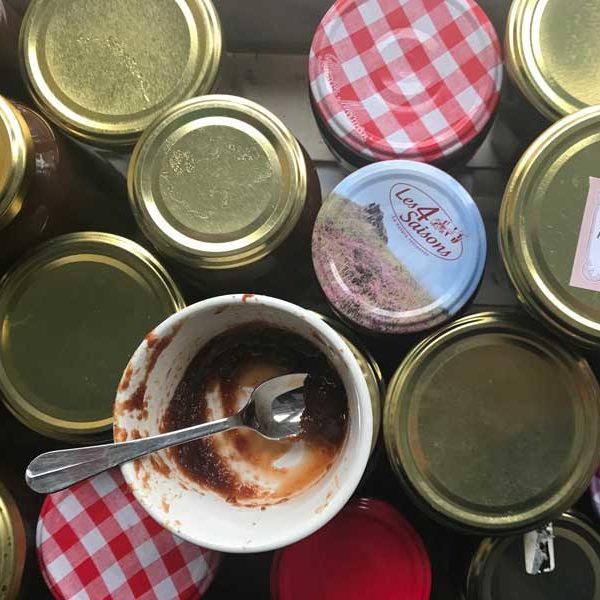
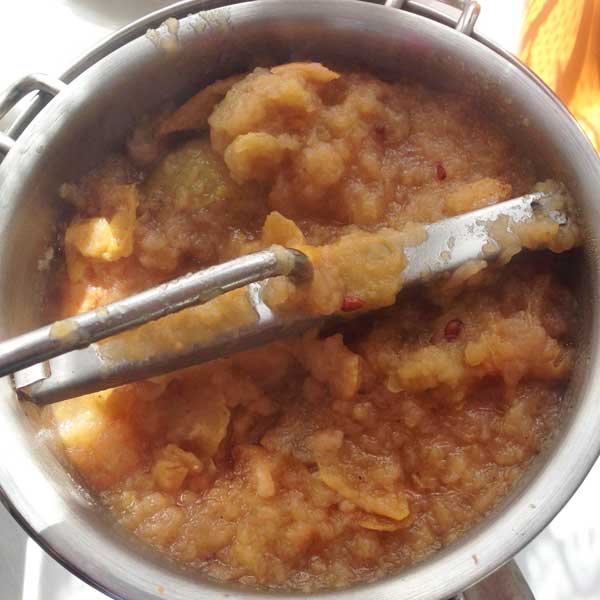
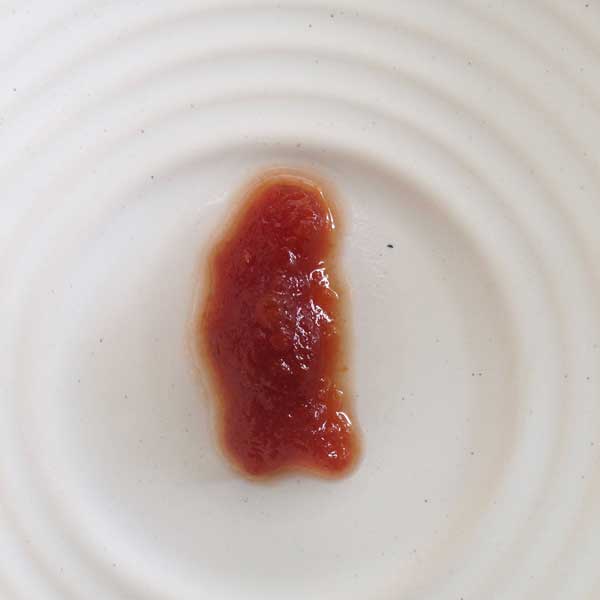
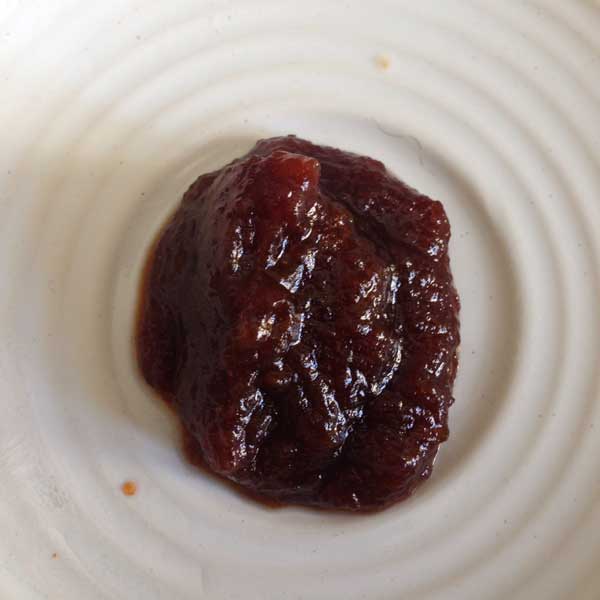
Over time, I’ve jiggered the original Joy of Cooking recipe for apple butter to suit my tastes – halving the sugar, eliminating all but a little cinnamon from the spice. I’ve also learned that there’s a lot left unsaid in the authors’ brief instructions. The main thing: apple butter takes a lot of time compared to other jams and preserves. It’s a day-long project between cutting up the apples (you need a lot of them!), reducing the apples down to an applesauce, and cooking that applesauce into a thick, dark, sweet, spreadable apple butter. Because of this time factor, making apple butter can either be a delight or a total drag, depending on how you go about it. Here’s how to make it a delight:
Choose a chilly, gray day when you won’t be tempted to go anywhere, a day when a warm fragrant kitchen (or nearby) is the only place you’ll want to be. Start in the morning or early afternoon so you won’t find yourself stirring and simmering at midnight. Plan for some type of entertainment—music, a good book, a friend stopping by—or some type of task to keep you busy between stirs. (I rearranged my kitchen cabinets this year.) Making apple butter is a great excuse to do nothing else…to kick back, slow down, stay in and cook up something infinitely better than anything you could find in any store.
Get cheap or free apples. You will need 4 to 6 pounds of apples to make it worth your while, and that can get pricey if you’re buying premium apples. I’m lucky in Cancale. I have a network of friends and neighbors who never know what to do with all the apples their trees produce—particularly the under-ripe, misshapen, slightly bruised windfall fruit—so they give them to me. I’m also surrounded by orchards who sell their fruit “seconds” and “thirds” for a song. But cheap/free apples can be found just about anywhere. When I lived in New York City, I got chummy with one of the Greenmarket growers who would give me cases of apples that were too bruised to sell. Elsewhere in the US, I found U-pick orchards that would also accommodate my requests and either give me fruit or sell it for a lot less. And don’t fuss over the type of apple you get. They all work—and a mix of varieties is best.
Use the largest pot you have. Even if you think an intermediate size will do. As apple butter cooks and thickens, it starts to spatter…and a pot is much easier to clean up than the stovetop and walls are. Plus, increased surface area means increased evaporation, which means a shortened cooking time.
Have some fresh bread on hand to “clean the pot.” Warm, just-made apple butter is the cook’s own sweet reward, so rather than wash any sticky remains down the drain, sop them up with some really good bread.
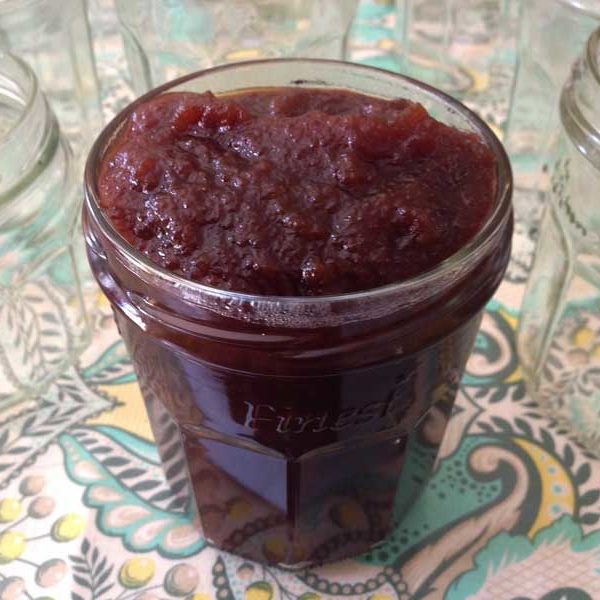
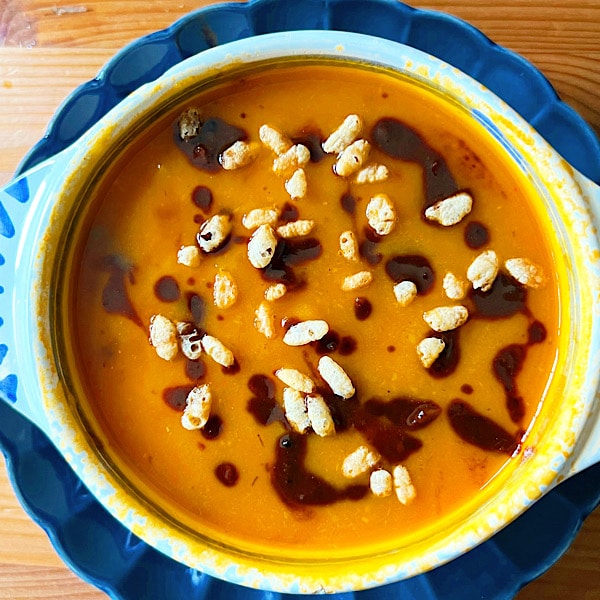

Leave A Comment